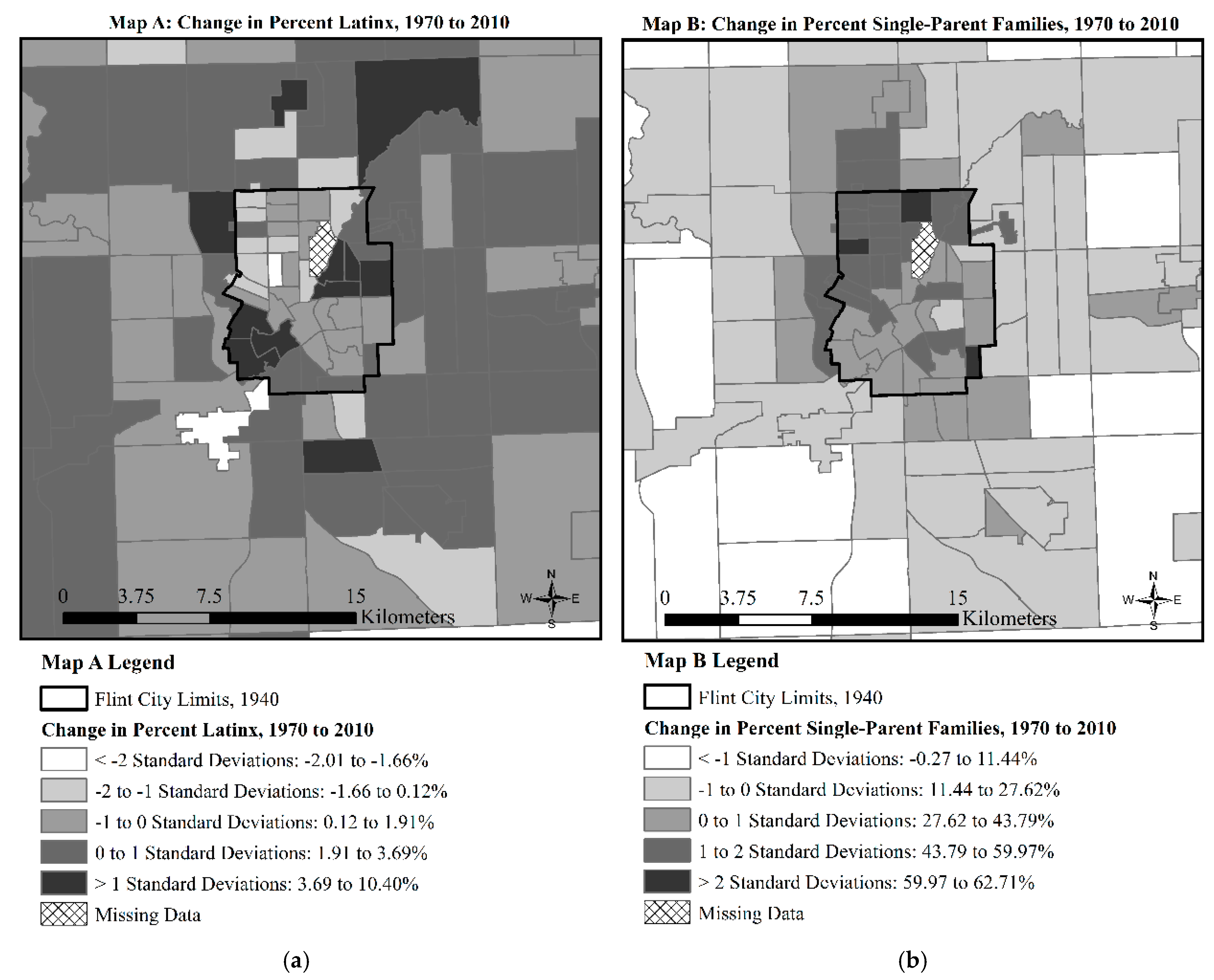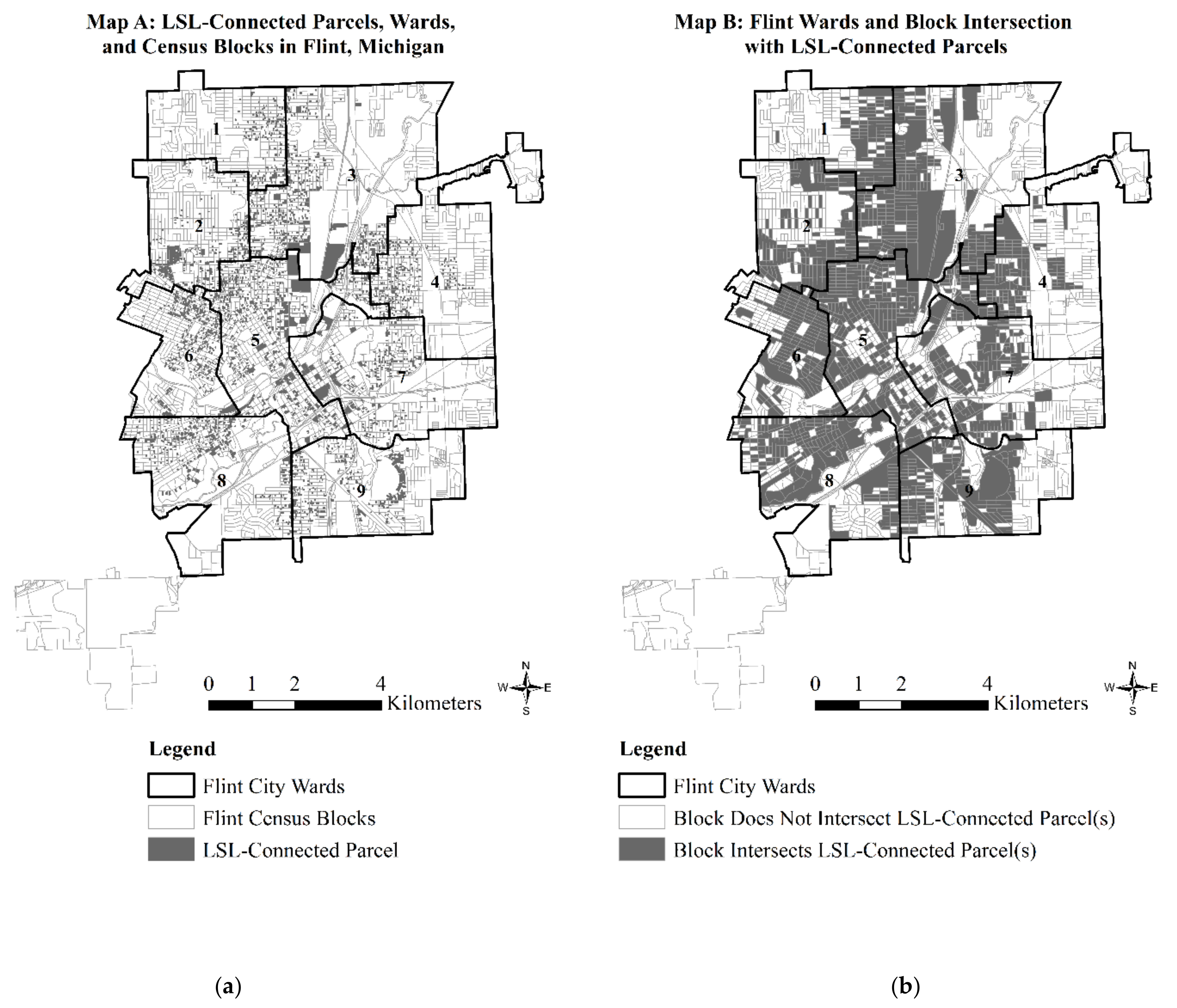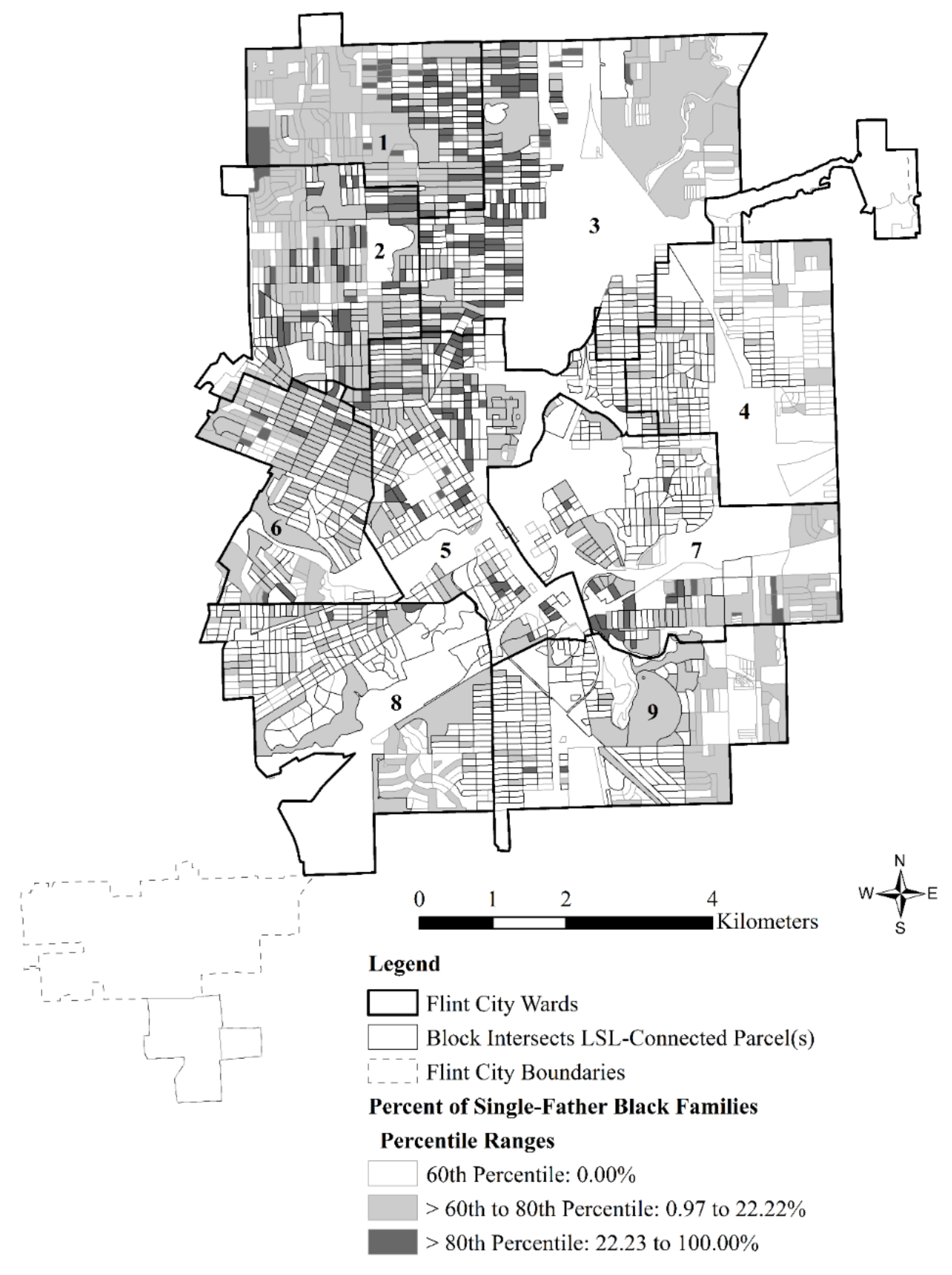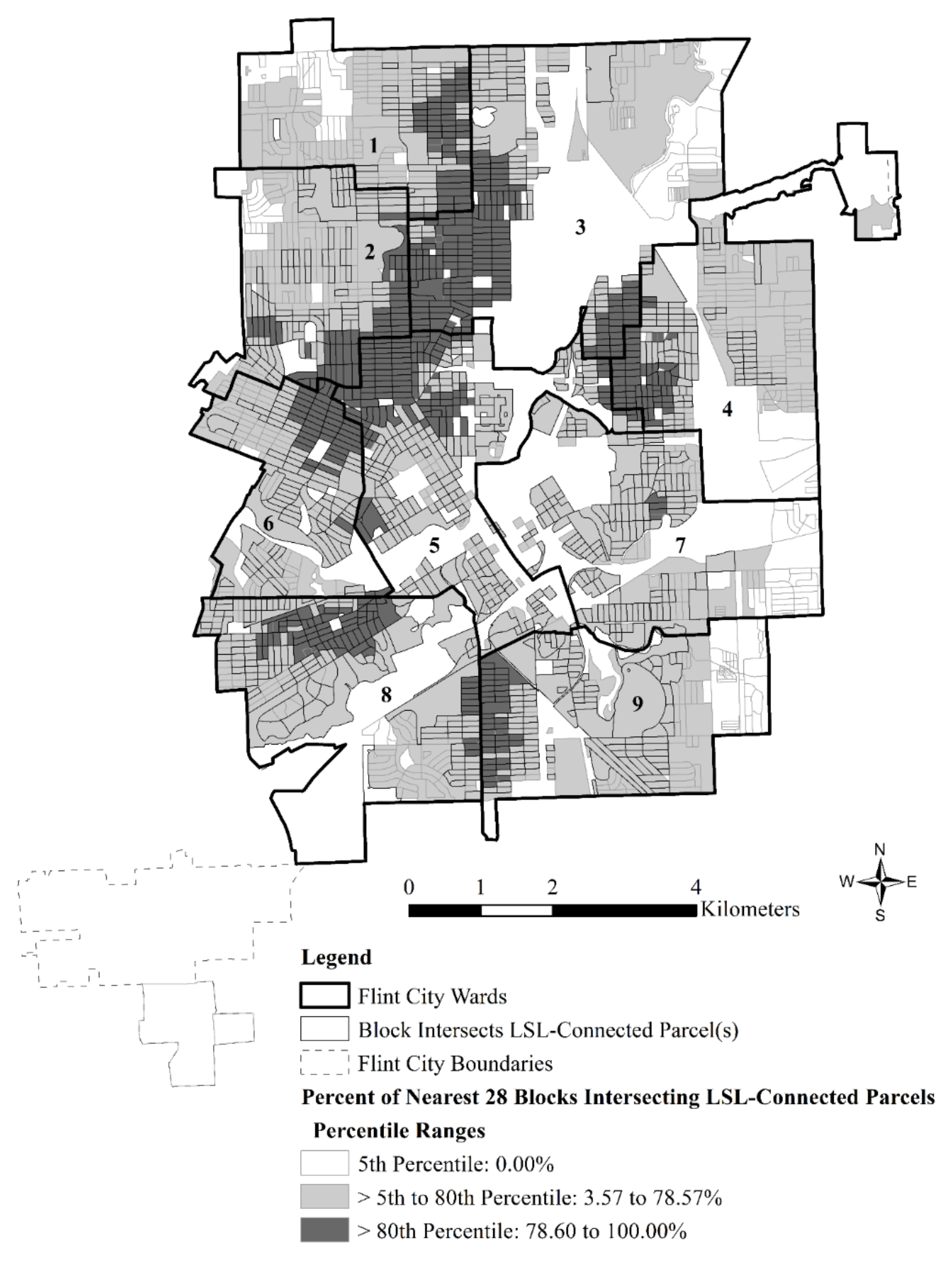An Intercategorical Ecology of Lead Exposure: Complex Environmental Health Vulnerabilities in the Flint Water Crisis
Abstract
1. Introduction
1.1. Background
1.2. Toward an Intercategorical Ecology of Lead Exposure
1.3. The Case of Flint
1.4. Research Aims
2. Materials and Methods
2.1. Unit of Analysis
2.2. Dependent Variable
2.3. Explanatory Variables
2.4. Control Variables
2.5. Analytical Strategy
3. Results
3.1. Descriptive Statistics
3.2. Likelihood of Block Exposure to LSL-Connected Parcels
4. Discussion
Limitations
5. Conclusions
Author Contributions
Funding
Institutional Review Board Statement
Informed Consent Statement
Data Availability Statement
Acknowledgments
Conflicts of Interest
Appendix A

| Variables | Model 1a | Model 1b | ||||
|---|---|---|---|---|---|---|
| B 1 | SE 2 | OR 3 | B | SE | OR | |
| Percentage of families: | ||||||
| Single-parent white | 0.000 | 0.002 | 1.000 | 0.001 | 0.002 | 1.001 |
| Single-parent Latinx | 0.021 ** | 0.008 | 1.021 | 0.015 † | 0.008 | 1.015 |
| Percentage of owner-occupied housing units | −0.012 *** | 0.002 | 0.988 | −0.005 * | 0.002 | 0.995 |
| Percentage of the nearest 28 blocks intersecting LSL-connected parcels | 0.058 *** | 0.002 | 1.060 | |||
| Constant | 0.834 *** | 0.111 | 2.303 | −2.408 *** | 0.188 | 0.090 |
| Pseudo R-squared | 0.030 | 0.469 | ||||
| –2 log likelihood | 2945.182 | 2050.658 | ||||
| Model chi-square | 50.280 *** | 944.804 *** | ||||
| Degrees of freedom | 3 | 4 | ||||
| Moran’s I of regression residuals 4 | 0.343 *** | −0.007 | ||||
| Variables | Model 2a | Model 2b | ||||
|---|---|---|---|---|---|---|
| B 1 | SE 2 | OR 3 | B | SE | OR | |
| Percentage of families: | ||||||
| Single-parent Black | 0.001 | 0.001 | 1.001 | 0.001 | 0.002 | 1.001 |
| Single-parent Latinx | 0.021 ** | 0.008 | 1.022 | 0.016 † | 0.008 | 1.016 |
| Percentage of owner-occupied housing units | −0.012 *** | 0.002 | 0.989 | −0.005 * | 0.002 | 0.995 |
| Percentage of the nearest 28 blocks intersecting LSL-connected parcels | 0.058 *** | 0.002 | 1.060 | |||
| Constant | 0.802 *** | 0.130 | 2.229 | −2.425 *** | 0.207 | 0.088 |
| Pseudo R-squared | 0.030 | 0.469 | ||||
| –2 log likelihood | 2944.989 | 2050.642 | ||||
| Model chi-square | 50.473 *** | 944.821 *** | ||||
| Degrees of freedom | 3 | 4 | ||||
| Moran’s I of regression residuals 4 | 0.343 *** | −0.007 | ||||
| Variables | Model 3a | Model 3b | ||||
|---|---|---|---|---|---|---|
| B 1 | SE 2 | OR 3 | B | SE | OR | |
| Percentage of families: | ||||||
| Single-mother white | 0.003 | 0.003 | 1.003 | 0.003 | 0.003 | 1.003 |
| Single-mother Latina | 0.026 ** | 0.010 | 1.026 | 0.022 † | 0.011 | 1.022 |
| Single-father white | 0.000 | 0.004 | 1.000 | 0.002 | 0.005 | 1.002 |
| Single-father Black | 0.015 *** | 0.004 | 1.015 | 0.011 * | 0.005 | 1.012 |
| Single-father Latino | 0.014 | 0.012 | 0.243 | 0.007 | 0.013 | 0.573 |
| Percentage of owner-occupied housing units | −0.011 *** | 0.002 | 0.989 | −0.004 † | 0.002 | 0.996 |
| Percentage of the nearest 28 blocks intersecting LSL-connected parcels | 0.058 *** | 0.002 | 1.060 | |||
| Constant | 0.639 *** | 0.122 | 1.895 | −2.564 *** | 0.201 | 0.077 |
| Pseudo R-squared | 0.039 | 0.472 | ||||
| –2 log likelihood | 2930.553 | 2044.854 | ||||
| Model chi-square | 64.909 *** | 950.609 *** | ||||
| Degrees of freedom | 6 | 7 | ||||
| Moran’s I of regression residuals 4 | 0.340 *** | −0.007 | ||||
| Variables | Model 2a | Model 2b | ||||
|---|---|---|---|---|---|---|
| B 1 | SE 2 | OR 3 | B | SE | OR | |
| Percentage of families: | ||||||
| Single-mother Black | −0.002 | 0.002 | 0.998 | −0.001 | 0.002 | 0.999 |
| Single-mother Latina | 0.026 ** | 0.010 | 1.027 | 0.022 * | 0.011 | 1.023 |
| Single-father white | −0.001 | 0.005 | 0.999 | 0.001 | 0.006 | 1.001 |
| Single-father Black | 0.014 *** | 0.004 | 1.014 | 0.011 * | 0.005 | 1.011 |
| Single-father Latino | 0.014 | 0.012 | 1.014 | 0.007 | 0.013 | 1.007 |
| Percentage of owner-occupied housing units | −0.012 *** | 0.002 | 0.988 | −0.005 | 0.002 | 0.995 |
| Percentage of the nearest 28 blocks intersecting LSL-connected parcels | 0.058 *** | 0.002 | 1.060 | |||
| Constant | 0.830 *** | 0.146 | 2.294 | −2.439 *** | 0.223 | 0.087 |
| Pseudo R-squared | 0.039 | 0.471 | ||||
| –2 log likelihood | 2930.360 | 2045.279 | ||||
| Model chi-square | 65.102 *** | 950.184 *** | ||||
| Degrees of freedom | 6 | 7 | ||||
| Moran’s I of regression residuals 4 | 0.339 *** | −0.007 | ||||
References
- U.S. Centers for Disease Control and Prevention. CDC Response to Advisory Committee on Childhood Lead Poisoning Prevention Recommendations. In Low Level Lead Exposure Harms Children: A Renewed Call of Primary Prevention; U.S. Centers for Disease Control and Prevention: Washington, DC, USA, 2012. Available online: https://www.cdc.gov/nceh/lead/acclpp/cdc_response_lead_exposure_recs.pdf (accessed on 27 October 2017).
- Meyer, P.A.; Pivetz, T.; Dignam, T.A.; Homa, D.M.; Schoonover, J.; Brody, D. Surveillance for elevated blood lead levels among children—United States, 1997–2001. MMWR-Surveill. Summ. 2003, 52, 1–21. Available online: https://www.ncbi.nlm.nih.gov/pubmed/14532866 (accessed on 1 August 2018).
- U.S. Agency for Toxic Substances and Disease Registry. Toxicological Profile for Lead; U.S. Agency for Toxic Substances and Disease Registry: Washington, DC, USA, 2007. Available online: https://www.atsdr.cdc.gov/toxprofiles/tp13.pdf (accessed on 27 October 2017).
- Muller, C.; Sampson, R.J.; Winter, A.S. Environmental inequality: The social causes and consequences of lead exposure. Annu. Rev. Sociol. 2018, 44, 263–282. [Google Scholar] [CrossRef]
- Troesken, W. The Great Lead Water Pipe Disaster; MIT Press: Cambridge, MA, 2006; ISBN 978-0-262-70125-9. [Google Scholar]
- Moody, H.; Darden, J.T.; Pigozzi, B.W. The racial gap in childhood blood lead levels related to socioeconomic position of residence in metropolitan Detroit. Sociol. Race Ethn. 2016, 2, 200–218. [Google Scholar] [CrossRef]
- Sampson, R.J.; Winter, A.S. The racial ecology of lead poisoning: Toxic inequality in Chicago neighborhoods, 1995–2013. Du Bois Rev. Soc. Sci. Res. Race 2016, 13, 261–283. [Google Scholar] [CrossRef]
- Hanna-Attisha, M.; LaChance, J.; Sadler, R.C.; Schnepp, A.C. Elevated blood lead levels in children associated with the Flint drinking water crisis: A spatial analysis of risk and public health responses. Am. J. Public Health 2016, 106, 283–290. [Google Scholar] [CrossRef] [PubMed]
- Pieper, K.J.; Tang, M.; Edwards, M.A. Flint water crisis caused by interrupted corrosion control: Investigating ‘ground zero’ home. Environ. Sci. Technol. 2017, 51, 2007–2014. [Google Scholar] [CrossRef]
- Michigan Civil Rights Commission. The Flint Water Crisis: Systemic Racism through the Lens of Flint. Michigan Department of Civil Rights, Michigan Civil Rights Commission: Lansing, MI, USA, 2017. Available online: https://www.michigan.gov/documents/mdcr/VFlintCrisisRep-F-Edited3-13-17_554317_7.pdf (accessed on 1 August 2018).
- Sadler, R.C.; Highsmith, A.R. Rethinking Tiebout: The contribution of political fragmentation and racial/economic segregation to the Flint water crisis. Environ. Justice 2016, 9, 143–151. [Google Scholar] [CrossRef]
- Pulido, L. Flint, environmental racism, and racial capitalism. Capitalism Nature Socialism 2016, 27, 1–16. [Google Scholar] [CrossRef]
- Kennedy, C.; Yard, E.; Dignan, T.; Buchanan, S.; Condon, S.; Brown, M.J.; Raymond, J.; Rogers, H.S.; Sarisky, J.; de Castro, R.; et al. Blood lead levels among children aged <6 years—Flint, Michigan, 2013–2016. MMWR-Morb. Mortal. Wkly. Rep. 2016, 65, 650–654. [Google Scholar] [CrossRef]
- Sadler, R.C.; LaChance, J.; Hanna-Attisha, M. Social and built environmental correlates of predicted blood lead levels in the Flint water crisis. Am. J. Public Health 2017, 107, 763–769. [Google Scholar] [CrossRef] [PubMed]
- University of Michigan-Flint Geographic Information Center. City of Flint Mapping of Lead Service Line Connections; University of Michigan-Flint Geographic Information Systems Center: Flint, Michigan, USA, 2016; Available online: https://www.umflint.edu/gis/gis-center-projects (accessed on 22 August 2017).
- McCall, L. The complexity of intersectionality. Signs 2005, 30, 1771–1800. [Google Scholar] [CrossRef]
- Liévanos, R.S. Race, deprivation, and immigrant isolation: The spatial demography of air-toxic clusters in the continental United States. Soc. Sci. Res. 2015, 54, 50–67. [Google Scholar] [CrossRef] [PubMed]
- Liévanos, R.S. Sociospatial dimensions of water injustice: The distribution of surface water toxic releases in California’s Bay-Delta. Sociol. Perspect. 2017, 60, 575–599. [Google Scholar] [CrossRef]
- Liévanos, R.S. Impaired water hazard zones: Mapping intersecting environmental health vulnerabilities and polluter disproportionality. ISPSR Int. J. Geo-Inf. 2018, 7, 433. [Google Scholar] [CrossRef]
- Liévanos, R.S. Air-toxic clusters revisited: Intersectional environmental inequalities and Indigenous deprivation in U.S. Environmental Protection Agency regions. Race Soc. Probl. 2019, 11, 161–184. [Google Scholar] [CrossRef]
- Hill Collins, P. Intersectionality’s definitional dilemmas. Annu. Rev. Sociol. 2015, 41, 1–20. [Google Scholar] [CrossRef]
- Crenshaw, K. Demarginalizing the intersection of race and sex: A Black feminist critique of antidiscrimination doctrine, feminist theory, and antiracist politics. Univ. Chicago Leg. For. 1989, 43, 139–167. Available online: http://chicagounbound.uchicago.edu/uclf/vol1989/iss1/8 (accessed on 1 August 2018).
- Crenshaw, K. Mapping the margins: Intersectionality, identity politics, and violence against women of color. Stanford Law Rev. 1991, 43, 1241–1279. [Google Scholar] [CrossRef]
- Hill Collins, P. Black Feminist Thought: Knowledge, Consciousness, and the Politics of Empowerment; Routledge: New York, NY, USA, 2009; ISBN 978-0-415-96472-2. [Google Scholar]
- Collins, T.W.; Grineski, S.E.; Chakraborty, J.; McDonald, Y.J. Understanding environmental health inequalities through comparative intracategorical analysis: Racial/ethnic disparities in cancer risks from air toxics in El Paso County, Texas. Health Place 2011, 17, 335–344. [Google Scholar] [CrossRef]
- Grineski, S.E.; Collins, T.W.; Chakraborty, J. Hispanic heterogeneity and environmental injustice: Intra-ethnic patterns of exposure to cancer risks from traffic-related air pollution in Miami. Popul. Environ. 2013, 35, 26–44. [Google Scholar] [CrossRef]
- Grineski, S.E.; Collins, T.W.; Morales, D.X. Asian Americans and disproportionate exposure to carcinogenic hazardous air pollutants: A national study. Soc. Sci. Med. 2017, 185, 71–80. [Google Scholar] [CrossRef]
- Crowder, K.; Downey, L. Interneighborhood migration, race, and environmental hazards: Modeling microlevel processes of environmental inequality. Am. J. Sociol. 2010, 115, 1110–1149. Available online: https://www.journals.uchicago.edu/doi/10.1086/649576 (accessed on 1 May 2013). [CrossRef] [PubMed]
- Downey, L.; Crowder, K.; Kemp, R.J. Family structure, residential mobility, and environmental inequality. J. Marriage Fam. 2017, 79, 535–555. [Google Scholar] [CrossRef] [PubMed]
- Downey, L.; Hawkins, B. Single-mother families and air pollution: A national study. Soc. Sci. Q. 2008, 89, 523–536. [Google Scholar] [CrossRef] [PubMed]
- McLanahan, S.; Percheski, C. Family structure and the reproduction of inequalities. Annu. Rev. Sociol. 2008, 34, 257–276. [Google Scholar] [CrossRef]
- Nakano Glenn, E. Unequal Freedom: How Race and Gender Shaped American Citizenship and Labor; Harvard University Press: Cambridge, MA, USA, 2002; ISBN 978-0-674-01372-8. [Google Scholar]
- Golash-Boza, T. Race and Racisms: A Critical Approach; Oxford University Press: New York, NY, USA, 2015; ISBN 978-0-190-23850-6. [Google Scholar]
- Golash-Boza, T. A critical and comprehensive sociological theory of race and racism. Sociol. Race Ethnicity 2016, 2, 129–141. [Google Scholar] [CrossRef]
- Kandaswamy, P. Gendering racial formation. In Racial Formation in the Twenty-first Century; HoSang, D.M., La Bennett, O., Pulido, L., Eds.; University of California Press: Berkeley, CA, USA, 2012; pp. 23–43. ISBN 978-0-520-27344-3. [Google Scholar]
- Ducre, A.K. The Black feminist spatial imagination and an intersectional environmental justice. Environ. Sociol. 2018, 4, 22–35. [Google Scholar] [CrossRef]
- Lefebvre, H. The Production of Space; Blackwell: Oxford, UK, 1991; ISBN 978-0-6311-8177-4. [Google Scholar]
- Flores, G.M. Controlling images of space: Latina teachers and racial positioning in multiracial schools. City Community 2015, 14, 410–432. [Google Scholar] [CrossRef]
- McCurn, A.S. “Keeping it fresh”: How young Black women negotiate self-representation and controlling images in urban space. City Community 2018, 17, 134–149. [Google Scholar] [CrossRef]
- Howard, C. Building a “family-friendly” metropolis: Sexuality, the state, and postwar housing policy. J. Urban. Hist. 2013, 39, 933–955. [Google Scholar] [CrossRef]
- Federal Housing Administration. Underwriting Manual; Government Printing Office, Section 1636: Washington, DC, USA, 1952. [Google Scholar]
- Canady, M. The Straight State: Sexuality and Citizenship in Twentieth Century America; Princeton University Press: Princeton, NJ, USA, 2009; ISBN 978-0-6911-4993-6. [Google Scholar]
- Cohen, L. A Consumer’s Republic: The Politics of Postwar Consumption in Postwar America; Knopf: New York, NY, USA, 2003; ISBN 0-375-70737-9. [Google Scholar]
- Cott, N. Public Vows: A History of Marriage and the Nation; Harvard University Press: Cambridge, MA, USA, 2000; ISBN 978-0-674-00875-5. [Google Scholar]
- Freund, D. Colored Property: State Policy and White Racial Politics in Suburban America; University of Chicago Press: Chicago, IL, USA, 2007; ISBN 978-0-2262-6276-5. [Google Scholar]
- Jackson, K. Crabgrass Frontier: The Suburbanization of the United States; Oxford University Press: New York, NY, USA, 1985; ISBN 978-0-195-04983-1. [Google Scholar]
- Highsmith, A.R. Demolition Means Progress: Flint, Michigan, and the Fate of the American Metropolis; University of Chicago Press: Chicago, IL, USA, 2015; ISBN 978-0-226-41955-8. [Google Scholar]
- Self, R. American Babylon: Race and the Struggle for Postwar Oakland; Princeton University Press: Princeton, NJ, USA, 2005; ISBN 978-0-691-12486-5. [Google Scholar]
- Furstenberg, F.F. The making of the Black family: Race and class in qualitative studies in the twentieth century. Annu. Rev. Sociol. 2007, 33, 429–448. [Google Scholar] [CrossRef]
- Anderson, E. Streetwise: Race, Class and Change in an Urban. Community; University of Chicago Press: Chicago, IL, USA, 1990; ISBN 978-0-226-01816-4. [Google Scholar]
- Wacquant, L. Urban. Outcasts: A Comparative Sociology of Advanced Marginality; Polity Press: Malden, MA, USA, 2008; ISBN 978-0-745-63125-7. [Google Scholar]
- Pellow, D.N. Toward a critical environmental justice studies: Black lives matter as an environmental justice challenge. Du Bois Rev. 2016, 13, 221–236. [Google Scholar] [CrossRef]
- Young, A.A. Are Black Men Doomed? Polity Press: Medford, MA, USA, 2018; ISBN 978-1-5095-2206-4. [Google Scholar]
- Williams, D.R. The health of men: Structured inequalities and opportunities. Am. J. Public Health 2003, 93, 724–731. Available online: https://ajph.aphapublications.org/doi/10.2105/AJPH.93.5.724 (accessed on 1 August 2018). [CrossRef]
- Griffith, D.M.; Gunter, K.; Allen, J.O. Male gender role strain as a barrier to African American men’s physical activity. Health Educ. Behav. 2011, 38, 482–491. [Google Scholar] [CrossRef] [PubMed]
- Liévanos, R.S. Green, blue, yellow, and red: The relational racialization of space in the Stockton metropolitan area. In Relational Formations of Race: Theory, Method and Practice; Molina, N., HoSang, D.M., Gutiérrez, R., Eds.; University of California Press: Berkeley, CA, USA, 2019; pp. 224–253. ISBN 978-0-5202-9967-2. [Google Scholar]
- Manson, S.; Schroeder, J.; Van Riper, D.; Ruggles, S. IPUMS National Historical Geographic Information Systems: Version 12.0 [Database]; University of Minnesota: Minneapolis, MN, USA, 2017. [Google Scholar] [CrossRef]
- U.S. Census Bureau. Technical Documentation: 2010 Census Summary File 1; U.S. Census Bureau: Washington, DC, USA, 2012.
- Lee, B.A.; Reardon, S.F.; Firebaugh, G.; Farrell, C.R.; Matthews, S.A.; O’Sullivan, D. Beyond the census tract: Patterns and determinants of racial segregation at multiple geographic scales. Am. Sociol. Rev. 2008, 73, 766–791. [Google Scholar] [CrossRef]
- Faust, J.; August, L.; Bangia, K.; Galaviz, V.; Leichty, J.; Prasad, S.; Schmitz, R.; Slocombe, A.; Welling, R.; Wieland, W.; et al. Update to the California Communities Environmental Health Screening Tool, CalEnviroScreen 3.0; Office of Environmental Health Hazard Assessment: Sacramento, CA, USA, 2017. Available online: https://oehha.ca.gov/calenviroscreen/report/calenviroscreen-30 (accessed on 2 January 2018).
- Goovaerts, P. How geostatistics can help you find lead and galvanized water service lines: The case of Flint, MI. Sci. Total Environ. 2017, 599–600, 1552–1563. [Google Scholar] [CrossRef]
- City of Flint. Ward Boundaries; City of Flint: Flint, MI, USA, 2018; Available online: https://www.cityofflint.com/wp-content/uploads/COFWard%20Boundariesreduced.pdf (accessed on 10 April 2018).
- Genesee County GIS Department. City of Flint Wards and Precincts; Genesee County GIS Department: Flint, MI, USA, 2012; Available online: https://www.cityofflint.com/wad-map/ (accessed on 10 April 2018).
- Mohai, P.; Saha, R. Racial inequality in the distribution of hazardous waste: A national-level reassessment. Soc. Probl. 2007, 54, 343–370. [Google Scholar] [CrossRef]
- Carstensen, J. One Reason Undocumented Immigrants didn’t Learn about Flint’s Lead Poisoning Sooner: There Wasn’t Much in Spanish. Public Radio International. 24 February 2016. Available online: https://www.pri.org/stories/2016-02-24/flints-undocumented-residents-face-unique-challenges-amid-water-crisis (accessed on 3 October 2017).
- O’ Reilly, A. Overlooked during Water Crisis, Flint’s Latino Community Paid Visit by Michigan Governor. Fox News. 8 February 2016. Available online: http://www.foxnews.com/world/2016/02/08/overlooked-during-water-crisis-flint-latino-community-paid-visit-by-michigan.html (accessed on 3 October 2017).
- Saenz-Acántara, C. Water in Flint’s Latino Neighborhoods Show Higher Traces of Lead. Latino Rebels, 25 January 2016. Available online: http://www.latinorebels.com/2016/01/25/water-in-flints-latino-neighborhoods-show-higher-traces-of-lead (accessed on 3 October 2017).
- Bazuin, J.T.; Fraser, J.C. How the ACS gets it wrong: The story of the American Community Survey and a small, inner city neighborhood. Appl. Geogr. 2013, 45, 292–302. [Google Scholar] [CrossRef]
- Folch, D.C.; Arribas-Bel, D.; Koschinsky, J.; Spielman, S.E. Spatial variation in the quality of American Community Survey estimates. Demography 2016, 53, 1535–1554. [Google Scholar] [CrossRef] [PubMed]
- Budd, E.E.; Liévanos, R.S.; Amidon, B. Open campus policies: How built, food, social, and organizational environments matter for Oregon’s public high school students’ health. Int. J. Environ. Res. Public Health 2020, 17, 469. [Google Scholar] [CrossRef] [PubMed]
- Desmond, M. Evicted: Poverty and Profit in the American City; Penguin Random House: New York, NY, USA, 2017; ISBN 978-0-5534-4745-3. [Google Scholar]
- Gotham, K.F. Race, Real Estate, and Uneven Development: The Kansas City Experience, 1900–2000; State University of New York Press: Albany, NY, USA, 2002; ISBN 0-7914-5378-2. [Google Scholar]
- McCabe, B.J. Why buy a home? Race, ethnicity, and homeownership preferences in the United States. Sociol. Race Ethn. 2018, 4, 452–472. [Google Scholar] [CrossRef]
- Pastor, M.; Morello-Frosch, R.; Sadd, J.L. The air is always cleaner on the other side: Race, space, and ambient air toxics exposures in California. J. Urban Aff. 2005, 27, 127–148. [Google Scholar] [CrossRef]
- DeFur, P.L.; Evans, G.W.; Cohen Hubal, E.A.; Kyle, A.D.; Morello-Frosch, R.A.; Williams, D.R. Vulnerability as a function of individual and group resources in cumulative risk assessment. Environ. Health Perspect. 2007, 115, 817–824. [Google Scholar] [CrossRef] [PubMed]
- Gee, G.C.; Payne-Sturges, D.C. Environmental health disparities: A framework integrating psychosocial and environmental concepts. Environ. Health Perspect. 2004, 112, 1645–1653. [Google Scholar] [CrossRef]
- Geronimus, A.T. The weathering hypothesis and the health of African-American women and infants: Evidence and speculations. Ethnicity Dis. 1992, 2, 207–221. Available online: https://pubmed.ncbi.nlm.nih.gov/1467758/ (accessed on 3 October 2017).
- City of Flint. FAST Start Pipe Replacement Program—City of Flint Service Line Replacements (as of 12/18/17); City of Flint: Flint, MI, USA, 2017; Available online: https://www.cityofflint.com/fast-start/ (accessed on 17 July 2018).
- Park, L.S.-H.; Pellow, D.N. The Slums of Aspen: Immigrants vs. the Environment in America’s Eden; New York University Press: New York, NY, USA, 2011; ISBN 978-0-8147-6803-7. [Google Scholar]
- Desmond, M. Eviction and the reproduction of urban poverty. Am. J. Sociol. 2012, 118, 88–133. [Google Scholar] [CrossRef]
- Krieger, N. Epidemiology and the web of causation: Has anyone seen the spider? Soc. Sci. Med. 1994, 39, 887–903. [Google Scholar] [CrossRef]
- Krieger, N. Epidemiology and the People’s Health: Theory and Context; Oxford University Press: New York, NY, USA, 2011; ISBN 978-0-1993-4842-8. [Google Scholar]
- GeoLytics. Neighborhood Change Database (NCDB) 1970–2010; GeoLytics, Inc.: New Brunswick, NJ, USA, 2012. [Google Scholar]




| Variable | Mean | Standard Deviation |
|---|---|---|
| Dependent variable: | ||
| Blocks intersecting LSL-connected parcels | 0.58 | 0.49 |
| Explanatory variables: | ||
| Percentage of families: | ||
| Single-parent white | 18.93 | 23.39 |
| Single-parent Black | 37.96 | 32.73 |
| Single-parent Latinx | 2.18 | 6.73 |
| Single-mother white | 13.50 | 18.41 |
| Single-mother Black | 31.09 | 28.82 |
| Single-mother Latina | 1.48 | 5.19 |
| Single-father white | 5.43 | 11.13 |
| Single-father Black | 6.87 | 12.25 |
| Single-father Latino | 0.71 | 3.96 |
| Control variables: | ||
| Percentage of owner-occupied housing units | 46.78 | 23.42 |
| Percentage of the nearest 28 blocks intersecting LSL-connected parcels | 52.21 | 28.44 |
| Variables | Model 1a | Model 1b | ||||
|---|---|---|---|---|---|---|
| B 1 | SE 2 | OR 3 | B | SE | OR | |
| Percentage of families: | ||||||
| Single-parent white | 0.001 | 0.003 | 1.001 | 0.002 | 0.003 | 1.002 |
| Single-parent Black | 0.001 | 0.002 | 1.001 | 0.002 | 0.002 | 1.002 |
| Single-parent Latinx | 0.021 ** | 0.008 | 1.021 | 0.015 † | 0.008 | 1.015 |
| Percentage of owner-occupied housing units | −0.011 *** | 0.002 | 0.989 | −0.005 | 0.003 | 0.995 |
| Percentage of the nearest 28 blocks intersecting LSL-connected parcels | 0.058 *** | 0.002 | 1.060 | |||
| Constant | 0.732 *** | 0.185 | 2.079 | −2.534 *** | 0.262 | 0.079 |
| Pseudo R-squared | 0.031 | 0.469 | ||||
| –2 log likelihood | 2944.710 | 2050.179 | ||||
| Model chi-square | 50.753 *** | 945.283 *** | ||||
| Degrees of freedom | 4 | 5 | ||||
| Moran’s I of regression residuals 4 | 0.358 *** | −0.001 | ||||
| Variables | Model 2a | Model 2b | ||||
|---|---|---|---|---|---|---|
| B 1 | SE 2 | OR 3 | B | SE | OR | |
| Percentage of families: | ||||||
| Single-mother white | 0.002 | 0.003 | 1.002 | 0.002 | 0.004 | 1.002 |
| Single-mother Black | −0.002 | 0.002 | 0.998 | 0.000 | 0.003 | 1.000 |
| Single-mother Latina | 0.026 ** | 0.010 | 1.026 | 0.022 † | 0.011 | 1.022 |
| Single-father white | −0.001 | 0.005 | 0.999 | 0.001 | 0.006 | 1.001 |
| Single-father Black | 0.015 *** | 0.004 | 1.015 | 0.011 * | 0.005 | 1.011 |
| Single-father Latino | 0.014 | 0.012 | 1.014 | 0.007 | 0.013 | 1.007 |
| Percentage of owner-occupied housing units | −0.011 *** | 0.002 | 0.989 | −0.005 | 0.003 | 0.995 |
| Percentage of the nearest 28 blocks intersecting LSL-connected parcels | 0.058 *** | 0.002 | 1.060 | |||
| Constant | 0.752 *** | 0.185 | 2.122 | −2.533 *** | 0.263 | 0.079 |
| Pseudo R-squared | 0.039 | 0.472 | ||||
| –2 log likelihood | 2929.894 | 2044.823 | ||||
| Model chi-square | 65.568 *** | 950.640 *** | ||||
| Degrees of freedom | 7 | 8 | ||||
| Moran’s I of regression residuals 4 | 0.354 *** | −0.001 | ||||
Publisher’s Note: MDPI stays neutral with regard to jurisdictional claims in published maps and institutional affiliations. |
© 2021 by the authors. Licensee MDPI, Basel, Switzerland. This article is an open access article distributed under the terms and conditions of the Creative Commons Attribution (CC BY) license (http://creativecommons.org/licenses/by/4.0/).
Share and Cite
Liévanos, R.S.; Evans, C.R.; Light, R. An Intercategorical Ecology of Lead Exposure: Complex Environmental Health Vulnerabilities in the Flint Water Crisis. Int. J. Environ. Res. Public Health 2021, 18, 2217. https://doi.org/10.3390/ijerph18052217
Liévanos RS, Evans CR, Light R. An Intercategorical Ecology of Lead Exposure: Complex Environmental Health Vulnerabilities in the Flint Water Crisis. International Journal of Environmental Research and Public Health. 2021; 18(5):2217. https://doi.org/10.3390/ijerph18052217
Chicago/Turabian StyleLiévanos, Raoul S., Clare R. Evans, and Ryan Light. 2021. "An Intercategorical Ecology of Lead Exposure: Complex Environmental Health Vulnerabilities in the Flint Water Crisis" International Journal of Environmental Research and Public Health 18, no. 5: 2217. https://doi.org/10.3390/ijerph18052217
APA StyleLiévanos, R. S., Evans, C. R., & Light, R. (2021). An Intercategorical Ecology of Lead Exposure: Complex Environmental Health Vulnerabilities in the Flint Water Crisis. International Journal of Environmental Research and Public Health, 18(5), 2217. https://doi.org/10.3390/ijerph18052217





